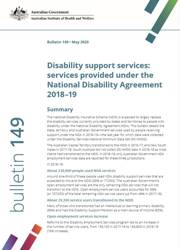Summary
The National Disability Insurance Scheme (NDIS) is expected to largely replace the disability services currently provided by states and territories to people with disability under the National Disability Agreement (NDA). This bulletin details the state, territory and Australian Government services used by people receiving support under the NDA in 2018–19—the last year for which data were collected under the Disability Services National Minimum Data Set (DS NMDS).
The Australian Capital Territory transitioned to the NDIS in 2016–17, and New South Wales in 2017–18. South Australia did not collect DS NMDS data in 2018–19 as most clients had transitioned to the NDIS. In 2018–19, only Australian Government NDA employment services data are reported for these three jurisdictions.
In 2018–19:
About 230,000 people used NDA services
Around one-third of these people used NDA disability support services that are expected to move to the NDIS (33% or 77,000). The Australian Government’s open employment services are the only remaining NDA services that will not transition to the NDIS. Open employment service users accounted for 68% (or 157,000) of the total remaining NDA service users (up from 49% in 2017–18).
About 29,200 service users transitioned to the NDIS
Many of those who transitioned had an intellectual or learning primary disability (65%) and had the Disability Support Pension as a main source of income (80%).
Open employment services increase
Reforms to the Disability Employment Services program led to an increase in the number of service users, from 136,100 in 2017–18 to 156,800 in 2018–19 (15% increase).
The average age of service users was 39
The characteristics of the NDA service user group continue to change as more and more service users transition to the NDIS. Most service users were aged under 65 (95%), while the average age of service users increased from 37 in 2017–18 to 39 in 2018–19.
The proportion of service users with an intellectual/learning disability continues to fall
About 29% of NDA service users had an intellectual/learning disability, down from 37% in 2017–18; 32% had a psychiatric disability in 2018–19, up from 25%. The decrease in the proportion of users with intellectual or learning disability over the last 5 years is largely the result of the transition of these service users to the NDIS.
Many service users were unemployed
Around three-quarters (77%) of services users aged 15 and over who were in the labour force were unemployed.
Many service users had an informal carer
About two-thirds (67%) of service users had an informal carer, most often their mother (65%). For around 13% of service users, their informal carer was aged 65 and over.
1. The disability services environment
2. Services provided under the NDA
3. Characteristics of service users
4. Informal carers
5. Service users who transitioned to the NDIS
End matter: Acknowledgments; Abbreviations; Symbols; References; Related publications



